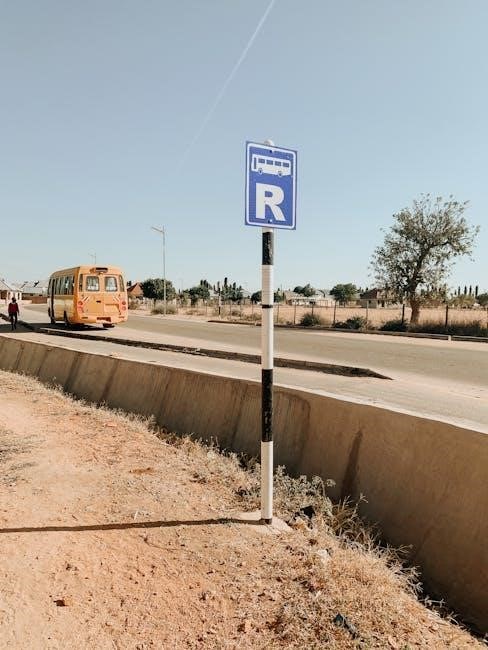Notice and Note Signposts are strategies for close reading, helping students identify crucial moments in texts. Created by Beers and Probst, they guide readers to question, explore, and interpret evidence, enhancing comprehension and engagement across various genres.
Overview of Notice and Note Signposts
The Notice and Note Signposts are six strategic markers designed to guide readers in identifying significant moments in texts. These markers—Contrasts and Contradictions, Aha Moments, Tough Questions, Words of the Wiser, Again and Again, and Memory Moments—help students engage deeply with literature. By recognizing these signposts, readers can pause, reflect, and explore the text’s underlying themes and meanings. These tools are adaptable to both fiction and nonfiction, fostering critical thinking and evidence-based interpretations. The Notice and Note approach ensures a structured yet flexible method for close reading, making complex texts more accessible and meaningful for learners of all levels.
Importance of Close Reading in Education
Close reading is a foundational skill that empowers students to deeply analyze and interpret texts, fostering critical thinking and comprehension. By engaging with complex texts, students develop the ability to uncover themes, evaluate evidence, and construct meaningful interpretations. This approach encourages active reading, transforming students into thoughtful, analytical learners. Close reading skills are essential for academic success, as they prepare students to tackle challenging texts across disciplines and cultivate a lifelong appreciation for literature and learning.
Structure of the Article
The Authors and Their Work

Kylene Beers and Bob Probst are prominent literacy educators who co-authored Notice and Note: Strategies for Close Reading. Their collaborative work focuses on enhancing reading comprehension through practical, evidence-based strategies, making complex texts accessible to all students. Their expertise has significantly influenced modern educational practices, providing teachers with effective tools to foster deeper engagement with literature and nonfiction texts.
Kylene Beers and Bob Probst: Background and Expertise
Kylene Beers, a renowned literacy expert, has dedicated her career to improving reading instruction. Her work emphasizes student engagement and critical thinking. Bob Probst, also a respected educator, specializes in creating practical classroom strategies. Together, they co-authored Notice and Note: Strategies for Close Reading, which introduced six key signposts to guide readers in identifying significant textual moments. Their expertise in educational research and hands-on teaching experience has made their strategies invaluable for educators seeking to enhance students’ reading skills and comprehension.
The Book “Notice and Note: Strategies for Close Reading”
Notice and Note: Strategies for Close Reading by Kylene Beers and Bob Probst offers a comprehensive approach to teaching close reading. The book introduces six key signposts—Contrasts and Contradictions, Aha Moments, Tough Questions, Words of the Wiser, Again and Again, and Memory Moments—that help students identify and analyze critical points in texts. It provides educators with practical strategies, examples, and questions to guide students in deeper comprehension and evidence-based discussions. This resource has become a cornerstone for implementing effective close reading practices in classrooms across various grades and subjects.

The Six Key Signposts in Fiction
The six key signposts—Contrasts and Contradictions, Aha Moments, Tough Questions, Words of the Wiser, Again and Again, and Memory Moments—help students identify significant textual moments, fostering deeper analysis and comprehension of fiction.
Contrasts and Contradictions
Contrasts and Contradictions occur when a character’s actions or words oppose expectations or earlier statements. This signpost alerts readers to potential conflicts or shifts in perspective, prompting questions like, “Why is this happening?” or “What does this reveal about the character?” By identifying these moments, students engage deeply with the text, uncovering underlying themes and motivations. This strategy encourages critical thinking and supports evidence-based interpretations, making it a powerful tool for close reading in both fiction and nonfiction contexts.
Aha Moments
Aha Moments are instances where a character experiences a sudden realization or insight, often marking a turning point in the story. These moments help students recognize shifts in understanding, encouraging them to question why the realization is significant. By identifying these moments, readers can uncover deeper themes, character motivations, and plot developments. Aha Moments highlight the importance of paying attention to changes in perspective, making them a key tool for fostering critical thinking and engagement during close reading activities.
Tough Questions
Tough Questions occur when characters or narrators pose challenging, thought-provoking inquiries that resonate with the story’s themes. These questions prompt readers to engage deeply with the text, exploring moral dilemmas, ambiguities, or unresolved issues; By identifying and analyzing these questions, students develop critical thinking skills, learning to seek answers within the text and make connections to broader themes. Tough Questions encourage readers to question assumptions and explore complexities, fostering a richer understanding of the narrative and its underlying messages.
Words of the Wiser
Words of the Wiser involve moments when a character, often older or more experienced, shares wisdom or advice that guides the protagonist. These insights can influence the main character’s decisions, offering life lessons or revealing themes. Readers should consider how this wisdom impacts the story’s direction and the character’s development. By noting these moments, students can better understand the narrative’s message and the character’s growth, fostering deeper connections between the text and its underlying truths.
Again and Again
The “Again and Again” signpost refers to repeated actions, phrases, or events in a text. These repetitions often emphasize key themes or ideas. Readers should ask why the author chose to repeat elements, as this can highlight patterns, reinforce motifs, or signal important developments. By identifying these recurrences, students can uncover deeper meanings and connections within the story, enhancing their understanding of the author’s intent and the narrative’s structure. This signpost encourages critical thinking about the significance of repetition in shaping the text’s message.
Memory Moments
A “Memory Moment” occurs when a character recalls a past event or experience. These moments provide insight into a character’s motivations, emotions, or backstory. Readers should stop and ask how this memory connects to the present action or theme. Memory Moments often reveal underlying conflicts, relationships, or lessons that shape the character’s decisions. By paying attention to these recollections, students can uncover deeper meanings and understand how the past influences the present narrative. This signpost helps readers make connections and interpret the significance of memories in the story’s development.
Implementing Notice and Note in the Classroom
Teachers introduce signposts one at a time, using guided practice and discussion. Students learn to identify and analyze signposts, fostering deep text exploration and critical thinking.
Introducing Signposts to Students
Introduce one signpost at a time, allowing students to grasp each concept thoroughly. Use instructional strategies like bookmarks, anchor charts, and modeled reading to familiarize students with the signposts. Begin by explaining the purpose of each signpost and provide clear examples. Use a mentor text to demonstrate how to identify and analyze signposts. Encourage students to ask questions and engage in discussions. Gradually transition from guided practice to independent application, ensuring students feel confident in their ability to notice and note signposts during their reading.
Practical Strategies for Teaching Close Reading
Implement close reading strategies by incorporating signposts into daily lessons. Use guided reading to model how to spot and analyze signposts. Provide students with bookmarks or tracking sheets to record observations. Encourage text marking, such as underlining or jotting notes, to engage deeply with the material. Incorporate small-group discussions to share insights and build understanding. Regularly review and discuss how signposts enhance comprehension, fostering a classroom culture of active reading and critical thinking. These methods ensure students develop the skills to independently apply close reading strategies in various texts.

Notice and Note Signposts for Nonfiction
Adapt signposts for nonfiction to help students identify key elements like data, claims, and comparisons. These strategies enhance critical thinking and analytical skills in informational texts.
Adapting Signposts for Nonfiction Texts
Adapting Notice and Note signposts for nonfiction involves focusing on elements like data, claims, and comparisons. These strategies help students critically analyze and interpret complex informational texts effectively.
Specific Examples and Applications
Nonfiction signposts like contrasts and data points guide students to analyze information. For example, when an author presents contrasting data, students can question the implications. These strategies encourage deeper understanding and critical thinking, making complex texts more accessible. By applying these methods, students can effectively interpret and evaluate nonfiction materials, fostering a stronger connection with the content.
PDF Resources and Additional Materials
Downloadable PDF guides provide detailed explanations of Notice and Note Signposts, including definitions, examples, and questions. These resources, available online, support close reading strategies and include worksheets and bookmarks for practical application. Links to purchase the book and supplementary materials are also accessible, offering comprehensive tools for educators and students.
Available PDF Guides and Worksheets
PDF guides and worksheets for Notice and Note Signposts are widely available, offering detailed explanations and practical tools for close reading. These resources include definitions, examples, and anchor questions for each signpost, helping students and educators apply the strategies effectively. Additionally, printable tracking sheets and bookmarks provide hands-on support for identifying and analyzing signposts in both fiction and nonfiction texts. Many of these materials are free to download, while others can be purchased alongside the book or through educational websites, making them accessible for classroom use and independent study.
Links to Purchase the Book and Related Resources
To access the Notice and Note resources, visit the official Heinemann website or platforms like Amazon to purchase the book “Notice and Note: Strategies for Close Reading” by Kylene Beers and Bob Probst. Additional PDF guides, worksheets, and signpost tracking sheets can be found on educational websites and teacher resource platforms like Teachers Pay Teachers. These materials are designed to support both classroom instruction and independent learning, providing comprehensive tools for mastering close reading strategies.


